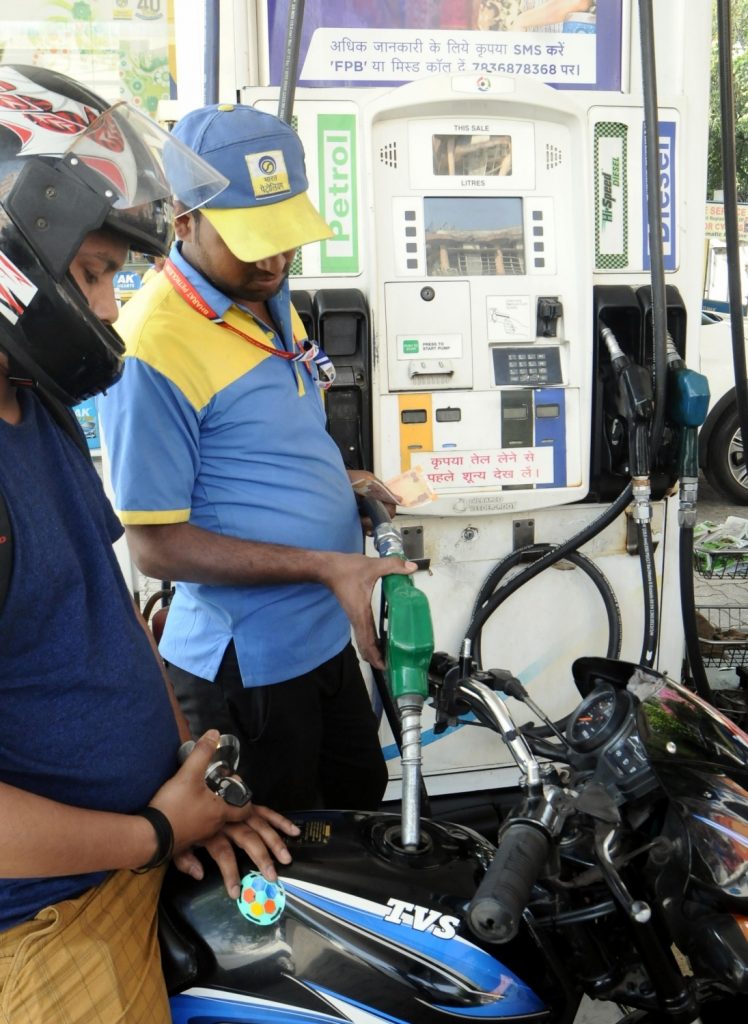The COVID-19 pandemic has laid bare the Indian government’s dependence on fossil fuels for revenue generation and this could impact the country’s plans for large-scale adoption of clean energy at a time when a ‘just’ energy-transition is crucial to address climate change.
For the most part of 2020, when the economy was in the doldrums, the rise in prices of petrol and diesel were often among the most discussed issues. The petrol prices crossed Rs. 100 per litre in several areas of the country and the issue has received significant attention in the ongoing assembly elections across five states and union territories as well.
But no amount of criticism has been able to impact the central government which has continuously defended high tax, around 60%, petroleum products statin that it is stating that it is necessary to improve the fiscal position of the country.
Anurag Singh Thakur, who is the minister of state for finance on March 15, said, “The excise duty rates have been calibrated to generate resources for infrastructure and other developmental items of expenditure keeping in view the present fiscal position.”
But this practice is not new and certainly not due to the COVID-19 pandemic alone. In fact, the present government has earned significant revenues from increasing taxes on fossil fuels since it came to power in 2014.
In 2013-14, the government of India earned Rs. 12.35 trillion (Rs. 12,35,870 crores) from the central excise duty on petrol, diesel and natural gas. It was about 4.3% of the budget estimate of gross total revenue (GTR) of the particular year.
In comparison to this, the Indian government received Rs. 24.23 trillion (Rs. 24,23,020 crores) from the central excise duty in just 10 months (April 2020 – January 2021) which is 12.2% of the budget estimate of the GTR.
A working paper ‘Energy: Taxes and Transition in India’ published by a Pune-based non-profit working in the energy sector, Prayas, highlights the Centre and states’ dependency on fossil fuel for their revenue generation.
- It notes that “the energy sector contributed about 18% to the tax revenue of the Centre and states in 2018-19, with the Centre’s dependence being greater (25%). At an aggregate level, states depend on the energy sector for 13% of their tax revenues.”
- In comparison to this, a country in the European Union earns only about 4.7% of total tax revenue from energy tax, the paper by Prayas claimed.
The government earns revenue from the energy sector in many ways including the goods and services tax (GST), the GST compensation cess, custom duty, excise duty, national calamity contingent duty and sales tax/value-added tax etc.
All these duties and taxes fall under the tax revenue. While under non-tax revenue, the government gets revenue through a royalty on coal, crude oil and natural gas and also contribute to the district mineral foundation funds.
Prayas’s paper claims that the revenue estimates from the energy sector – 25% for the Centre and 13% for the states – are conservative since it has considered only the primary revenue sources.
Ashok Sreenivas, a senior fellow at Prayas and one of the authors of the paper, said that the energy transition is going to take at least 10-20 years and for this, taxation is crucial.
Whenever energy transition is discussed, issues related to technology and its impact on people or society gets
Earnings from fossil fuels
When the present government came into power in 2014, it introduced a paradigm shift in energy taxation with a claim that high taxation of petroleum products acts as an implicit carbon tax.
In the national economic survey 2014-15, a whole chapter ‘From Carbon Subsidy to Carbon Tax: India’s Green Actions’ was dedicated to explaining the rationale behind putting more taxes on petroleum products with huge claims.
One of the claims was that the increased petrol and diesel price will serve as a price signal to reduce fuel burnt and carbon dioxide (CO2) emissions. However, the impact of the increase in price was not seen in terms of reduction in fuel burnt. In 2015-16, India burnt 184.6 million metric tonnes of petroleum products which increased to 214.1 million metric tonne in 2019-20.
It should be noted that despite heavy taxes, demand for energy has not gone down, noted R. Kavitha Rao, an economist associated with the National Institute of Public Finance and Policy (NIPFP). She was talking in reference with increase in fuel price in pandemic and its consumption.
When asked about the increased fuel prices not leading to reduced consumption, Chandra Bhushan, president and CEO of iForest, a think-tank working on environment and sustainability said this is a “nonsensical equation.”
“Increasing prices of essentials will not lead to less consumption. People don’t have other alternatives so they will cut their expenditure on other things but will continue to spend on fuel,” Bhushan told Mongabay-India.
In the same chapter of the 2014-15 national economic survey, the central government explained the rationale behind the increased coal cess from Rs. 50 per tonne to Rs. 100 per tonne with the claim to make it equivalent to a carbon tax of about one U.S. dollar per tonne. The coal cess was later increased to Rs. 400 per tonne.
But the twist in the tale is that the whole revenue collected as a ‘carbon tax’ under the name of clean energy cess was diverted to fill the revenue deficit of states under the GST instead of being used for clean energy projects.
Views are personal, Kundan Pandey
